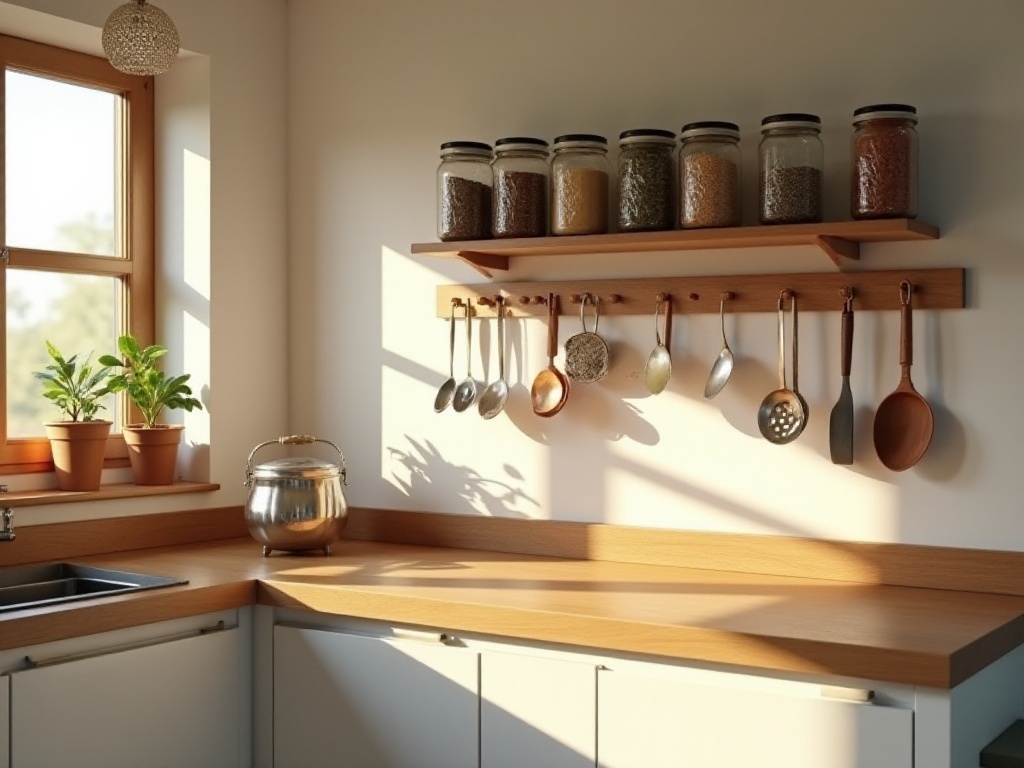Introduction
As a recent graduate and working professional experiencing the challenges of living in Beijing, I remember when I first moved into my 28-square-meter apartment. The sight of luggage and bags everywhere was overwhelming, and it took an entire weekend to sort through everything. I wondered how I would manage in such a small space. However, after two years of trial and error, I finally developed an organization system that not only keeps my small nest orderly but has significantly improved my living experience.
Now, coming home to a tidy and organized room brings me indescribable happiness. Today, I want to share my insights with others who might be struggling with organization.
Space Planning
When it comes to space planning, the most important thing is to change your mindset. Many people think their room is small because of limited floor space, but they're overlooking an important dimension - vertical space. From my observation, most people utilize less than 50% of their wall space, which is essentially wasting space!
For example, I installed a six-tier hook rack behind my door, which was previously a dead corner, instantly solving storage issues for coats, umbrellas, and bags. I also mounted several weight-bearing shelves on the wall for small plants and decorative items, both beautifying the environment and maximizing vertical space.
Speaking of vertical space utilization, Japanese home design principles are worth mentioning. During my studies in Japan, I was amazed at how comfortably they lived in small spaces. They build cabinets up to the ceiling and even elevate beds to create storage space underneath. These design concepts greatly inspired me.
After improving my vertical space usage, my storage capacity increased by over 40%. And because items are stored on the walls, the floor space feels much more open. Now when friends visit, they're surprised at how spacious my small room appears.

Organization Principles
When people think about organization, many immediately think "shopping." Various storage solutions on Taobao look tempting. I was the same way initially, but buying lots of storage containers didn't make my room neater - instead, these items took up more space, making it feel more cramped.
Later, I developed my "Three Hearts, Two Minds" principle, which became my organization bible:
Convenience: Items should be easily accessible after organization. For example, my wardrobe is organized by frequency of use. Most-worn clothes are in the most accessible locations, while seasonal items can be stored higher or lower.
Simplicity: The organization system should be easy to maintain. If a storage solution requires too much time to maintain, it won't be sustainable. I once bought a storage box that required perfect folding to fit items - I gave up after two days because it was too troublesome.
Satisfaction: Visual effects should be pleasing. Organization isn't just about hiding things; it's about making the entire space look appealing. I now prefer using storage boxes in coordinating colors, which are both practical and attractive when displayed on shelves.
Flexibility: Storage locations should be based on usage frequency. I categorize items into three groups: daily use, occasional use, and rarely used. This frequency determines storage location, ensuring both convenience and tidiness.
Coherence: Related items should be stored together. For example, I keep my makeup and skincare products in the same area for convenience.
Zone Organization
After covering principles, let's discuss specific implementation. I've divided my 28-square-meter home into four functional zones: sleeping area, work area, storage area, and living area. Each zone has its unique storage characteristics and needs.
The sleeping area's focus is maintaining cleanliness and comfort. My custom loft bed has 40 centimeters of storage space underneath. In this space, I placed four flat storage boxes with wheels, storing seasonal clothes, bedding, travel items, and collectibles. These boxes are transparent, so I can see the contents without pulling them out. The wheels make accessing items convenient.
The work area emphasizes efficiency. I made many modifications around my desk, including installing a suspended file organizer for frequently used documents and materials. On the desk, I use a rotating pen holder for easy access to stationery. Under the keyboard, I have a wrist rest with storage functionality for small items.
The storage area mainly consists of wardrobes and storage cabinets. My wardrobe uses a layered organization system: the top section is for hanging clothes like coats and shirts that need to avoid wrinkles. The middle section has drawers for smaller clothing items and accessories. The bottom section is for shoes, stored in transparent boxes and categorized.
The living area includes a simple kitchen and bathroom. Though the kitchen is small, it's fully functional. I installed a folding table on the wall that serves as a dining table and can be folded away when not in use. Spices and utensils are stored on magnetic racks, saving space while remaining accessible.

Smart Tool Usage
To do a job well, one must first sharpen their tools. Regarding storage tools, I've tried and filtered countless options to find these truly useful items:
Vacuum storage bags are revolutionary for organization! I was amazed when I first used them to store winter down jackets. Winter clothes that previously occupied half the wardrobe now fit in a single drawer. Today's vacuum bags are quite durable - the ones I've used for two years are still intact. Tip: Choose bags with hand pumps so you don't need to use a vacuum cleaner every time.
Hooks and storage racks are my most indispensable organization tools. I have hooks everywhere - the bathroom alone has more than a dozen. Some hold towels, others hold hair dryers, and some hold storage baskets. Most of these hooks are removable adhesive types that won't damage walls and are convenient for moving. For storage racks, I chose non-drilling bathroom shelves that have excellent weight-bearing capacity and are water-resistant.
The choice of storage boxes is also important. I now use transparent boxes, eliminating the need for labels as contents are visible at a glance. I chose boxes from the same brand and series, creating a unified aesthetic while allowing for stacking to save space. When selecting storage box sizes, I measure the intended storage area first to avoid buying boxes that won't fit.
Besides these basic tools, I have some particularly useful small items. For example, the clothes folding board in my wardrobe helps fold clothes uniformly and neatly for organized storage. The drawer dividers can be freely combined to create different-sized compartments, preventing small items from becoming messy.

Organization Pitfalls
During my two years of organization exploration, I've not only gained experience but also encountered many pitfalls. Let me share some common organization mistakes to help others avoid them:
The most typical mistake is hoarding organization products. I remember when I first started organizing, I couldn't resist buying storage products and wanted to buy every "miracle" organizer on Taobao. This not only wasted money but created new storage burdens with the organization products themselves. Now I advise thinking carefully about what needs to be stored and what kind of storage tools are needed before making purchases.
Over-organization is another common issue. Some people, in pursuit of neatness, store everything away so thoroughly that accessing items becomes a hassle. I made this mistake before, storing frequently used stationery in drawers, making it time-consuming to find things. Later, I changed my strategy, keeping frequently used items within reach, neatly arranged in transparent containers or pen holders.
Blindly following trends should also be avoided. Many organization experts share their solutions on social media, and they all look perfect. But remember, someone else's solution may not suit you. For example, some organization experts fold all clothes to the same size, which looks neat but isn't practical if you're too busy to fold clothes so precisely.
Another pitfall is pursuing perfection. Many people think organization is only successful if everything is perfectly neat, creating unnecessary psychological pressure. The purpose of organization is to make life more convenient, not for display. If it makes your life easier and helps you find things more quickly, that's good organization.

Continuous Improvement
Organization isn't a one-time task; it requires constant adjustment and optimization. I maintain a monthly organization check habit, typically spending one afternoon organizing and adjusting.
During checks, I pay special attention to these aspects:
Changes in usage frequency: Some previously frequently used items might become less used, requiring storage location adjustments. For example, some makeup products I used to use often are now used less frequently, so I moved them from the vanity to storage boxes.
Storage method rationality: Check if current storage methods are still suitable and need improvement. For instance, if I notice some drawer divisions aren't working well and items often become messy, I'll readjust the divider positions.
Item updates and elimination: Use organization time to clear out unnecessary items. For things unused for a long time and unlikely to be used in the future, I dispose of them decisively.
Storage product condition: Check if storage items are in good condition and need replacement or replenishment. Some storage boxes might be damaged, or compression bags might need replacement.
Through such regular checks and adjustments, I've found organization effectiveness has improved significantly. The room stays neat, and finding things has become more convenient.

Summary Reflections
After two years of practice, I deeply understand that good organization can truly change life quality. I remember initially having to search through piles of items every day when returning home, which made me irritable. Now, every time I open the door to see an organized room, I feel great.
Moreover, I've found good organization isn't just about keeping spaces neat; more importantly, it saves time and energy. No more worrying about finding things or stressing about tidying up - it feels wonderful.
The biggest insight organization has given me is: life needs planning but doesn't need to be perfect. Finding what works for you is most important. Like my current organization system - it might not be perfect, but it's practical and sustainable.
Extended Thoughts
At this point, you might wonder why so many people are pursuing minimalist living nowadays. In my view, this might be related to characteristics of our era.
Young people today live at a fast pace with high work pressure. Coming home to face a room full of clutter would only worsen their mood. Therefore, organizing to make life more orderly is actually our pursuit of a better life.
This also reflects modern people's emphasis on life quality. We're no longer satisfied with basic necessities but are pursuing higher quality living. A neat and organized living environment not only makes our lives easier but brings more happiness.
Of course, organization is just a means, not an end. What's truly important is how organization as a small matter makes our lives more beautiful. Perhaps this is the ultimate wisdom of organization.


